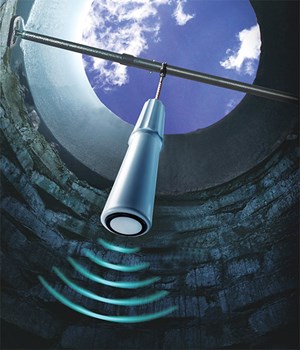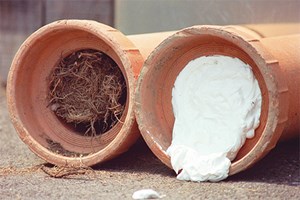October 2023 Vol. 78 No.10
Features
Asset management: Working with Duke’s ‘like having a crystal ball’
Corinna Hunt | Contributing Editor
(UI) — When optimizing sewer and wastewater treatment systems, it can be overwhelming to look at more than 100 miles of sewer pipe funneling heavy flow during a rain event and wonder where that excess flow is coming from.
“When somebody hands you a heat map and says, ‘these red pipes are taking on water,’ it really makes it easy to go out and determine where you need to spend your money for upgrading the system,” said David Henson, environmental quality superintendent for the Anniston Waterworks and Sewer Board in Anniston, Alabama. “The value of knowing where to look, it’s like having a crystal ball.”
That map and that value are what Duke’s provides. The Illinois-based business has worked in the sewer industry for a century, and its core service for the past several decades has been root control, said Stuart Tillery, who has 24 years with the company.
“Utilities hire us to treat their lines and kill the roots to prolong the life of their assets,” he said.
Because tree roots search for nutrients in water, and sewer pipes can develop condensation on their exterior, roots will detect that condensation and advance along the pipe until they can grow into a microscopic fissure.
Funnily enough, roots won’t grow where there is excessive groundwater because they’ll drown there, but “it doesn’t take anything for a root to get into a pipe,” Tillery said. “Then when they get in, they try to reach down for the water in there. It’s the ultimate nutrition for them, so they get real aggressive.”
One way to address the problem is for utilities to use a machine to cut out the roots – a quick and easy way to ensure removal. However, similar to cutting back a shrub, the plant will grow back thicker and more quickly. This compounds the necessary maintenance, Tillery said.
Herbicide
Duke’s uses an herbicide, which tree roots draw up like water until it kills them about 10 inches outside of the pipe, he said. The company has only used two herbicides. In the early 2000s, Duke’s hired an expert in pesticide herbicides to help find a product that worked better and faster, with less of an environmental impact, than the product they’d been using.
The company has utilized this one ever since, with a two- to three-year guarantee per treatment and a warrantied retreatment rate of less than 1 percent.
“Our main objective was to have a very effective product that did not harm the biology of the wastewater treatment plant,” said Tillery. “The efficacy of the product has been more than we could have hoped for.”
More recently, Duke’s has expanded its offerings according to the needs of the client.
“Probably in the last two to three years, we’ve recognized there are other areas our clients are having issues with – most with I&I, infiltration and inflow,” he said. “Infiltration and inflow detection is probably our second-biggest service now. In several cases, we have a root control crew and an I&I detection crew working in the same town at one time.”
Duke’s offers a turnkey service of analyzing problems and returning a study to clients, in a fraction of the time of a traditional sewer system evaluation survey.
“If you can imagine having a process that used to take two or three years and now this process takes six months, at a fraction of the cost. It’s revolutionary,” Tillery pointed out.
Duke’s has successfully provided root control service for the Anniston Water Works and Sewer Board in the past. “Now what we use Duke’s for more than anything is micro-detection studies,” Henson related.
Micro-detection
Because sewer capacity is expensive and resources are limited, using sewer capacity to treat rainwater is not the best use of resources. Duke’s micro-detection study service has made it easier to identify where rainwater is entering the sewer system so that unnecessary flow can be limited, and those resources can be better utilized, Henson said.
One of Duke’s first micro-detection studies was done with Anniston, after Tillery came out selling flow level detection meters, he added.
“We really didn’t know what to do with them, and Stuart went through town and just put a few of them in to see what information we could gather and what we could do with it,” Henson said. “He tells me that turned into the first micro-detection study for Duke’s.”
He likened the process to installing an expandable shower curtain rod inside a manhole and hanging a probe from it. Tillery left the meters in Anniston’s sewer system for three months; the amount of information collected was more than Henson expected.
Installing 147 flow detection meters in 26 miles of pipe, Duke’s provided Anniston with thousands of data points.
“They were able to say, ‘between meter 1 and meter 2’ or ‘between meter 123 and meter 133’ that you were taking on a percentage of flow,” Henson said. “They simplified it down to a heat map where I could pull up my [geographic information system] and look at the pipes that had turned red and know those were taking on flow.
“I could look at the pipes that turned orange and know they were taking on flow, as well, but not as much. The green pipes and the yellow pipes on the map I didn’t worry about, because they just weren’t taking on enough to create issues.”
More info
Additionally, Duke’s can determine which pipes are taking on heavier flow during rain events, and which ones are simply carrying the water that’s been taken on somewhere else.
“We call it ‘culprits’ and ‘carriers,’” Tillery said. “We’re going to show you where your culprits are, the ones that are actually adding it, and not the ones that are just carrying it from somewhere else.”
Within two rain events, Duke’s can collect the data needed.
“We take this information, and we smoke test, and we’ve found hundreds of clean-outs that we wouldn’t have found that were taking on water,” Henson said.
Anniston has about 250 miles of sewer pipe and 5,000 manholes. So far, the Water Works and Sewer Board has conducted three micro-detection studies with Duke’s, covering about 20 percent of the system. With more to cover, Henson “absolutely” plans to work with Duke’s again.
For the Anniston Water Works and Sewer Board, the ultimate goal is to substantially reduce the amount of water that enters the wastewater treatment plant during rain events, Henson said. With Duke’s help, the Board already managed to eliminate a significant amount of problem areas through root treatment or finding flow that can be taken out of pipes. He believes in the end, they’ll be able to achieve that goal of substantially reducing infiltration and inflow.
Duke’s root control service is tried and true, Henson said, but the micro-detection is what he’s been excited about.
“Micro-detection is the most valuable information I’ve seen,” he said. “This is a fairly new technology, something that didn’t exist a few years ago – something I’m glad I found and I’m glad I got involved in from the beginning.”
Duke’s is trusted by thousands of utilities nationwide, Tillery stressed. “Regardless of what part of the country you’re in, Duke’s has a service that can help you.”
FOR MORE INFO:
Duke’s Root Control, (315) 472-4781, dukes.com







Comments